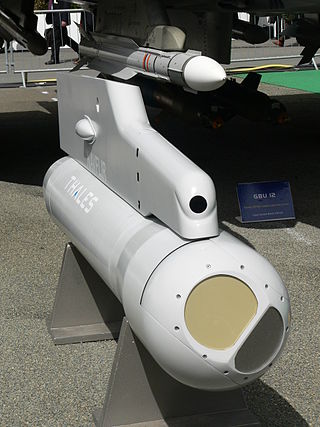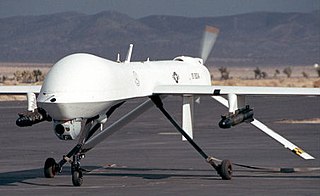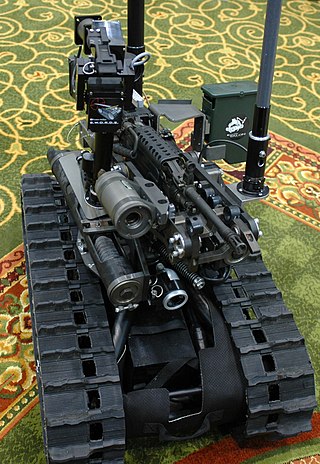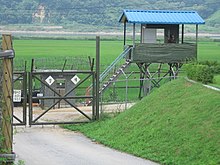An autonomous robot is a robot that acts without recourse to human control. The first autonomous robots environment were known as Elmer and Elsie, which were constructed in the late 1940s by W. Grey Walter. They were the first robots in history that were programmed to "think" the way biological brains do and meant to have free will. Elmer and Elsie were often labeled as tortoises because of how they were shaped and the manner in which they moved. They were capable of phototaxis which is the movement that occurs in response to light stimulus.

Forward-looking infrared (FLIR) cameras, typically used on military and civilian aircraft, use a thermographic camera that senses infrared radiation.

Military robots are autonomous robots or remote-controlled mobile robots designed for military applications, from transport to search & rescue and attack.

A thermographic camera is a device that creates an image using infrared (IR) radiation, similar to a normal camera that forms an image using visible light. Instead of the 400–700 nanometre (nm) range of the visible light camera, infrared cameras are sensitive to wavelengths from about 1,000 nm to about 14,000 nm (14 μm). The practice of capturing and analyzing the data they provide is called thermography.

Infrared thermography (IRT), thermal video and/or thermal imaging, is a process where a thermal camera captures and creates an image of an object by using infrared radiation emitted from the object in a process, which are examples of infrared imaging science. Thermographic cameras usually detect radiation in the long-infrared range of the electromagnetic spectrum and produce images of that radiation, called thermograms. Since infrared radiation is emitted by all objects with a temperature above absolute zero according to the black body radiation law, thermography makes it possible to see one's environment with or without visible illumination. The amount of radiation emitted by an object increases with temperature; therefore, thermography allows one to see variations in temperature. When viewed through a thermal imaging camera, warm objects stand out well against cooler backgrounds; humans and other warm-blooded animals become easily visible against the environment, day or night. As a result, thermography is particularly useful to the military and other users of surveillance cameras.

LANTIRN is a combined navigation and targeting pod system for use on the United States Air Force fighter aircraft—the F-15E Strike Eagle and F-16 Fighting Falcon manufactured by Martin Marietta. LANTIRN significantly increases the combat effectiveness of these aircraft, allowing them to fly at low altitudes, at night and under-the-weather to attack ground targets with a variety of precision-guided weapons.

An unmanned ground vehicle (UGV) is a vehicle that operates while in contact with the ground and without an onboard human presence. UGVs can be used for many applications where it may be inconvenient, dangerous, or impossible to have a human operator present. Generally, the vehicle will have a set of sensors to observe the environment, and will either autonomously make decisions about its behavior or pass the information to a human operator at a different location who will control the vehicle through teleoperation.
Hanwha Vision, founded as Samsung Techwin, is a video surveillance company. It is a subsidiary of Hanwha Group. The company employs 1,822 people and is headquartered in South Korea. Its total sales in 2020 were 529.8 billion South Korean won.

The Foster-Miller TALON remotely operated vehicle is a small, tracked military robot designed for missions ranging from reconnaissance to combat. It is made by the American robotics company QinetiQ-NA, a subsidiary of QinetiQ.

A sentry gun is a weapon that is automatically aimed and fired at targets that are detected by sensors. The earliest functioning military sentry guns were the close-in weapon systems point-defense weapons, such as the Phalanx CIWS, used for detecting and destroying short range incoming missiles and enemy aircraft, first used exclusively on naval assets, and now also as land-based defenses.

The K9 Thunder is a South Korean 155 mm self-propelled howitzer designed and developed by the Agency for Defense Development and civil contractors including Dongmyeong Heavy Industries, Kia Heavy Industry, Poongsan Corporation, and Samsung Aerospace Industries for the Republic of Korea Armed Forces, and is now manufactured by Hanwha Defense. K9 howitzers operate in groups with the K10 automatic ammunition resupply vehicle variant.

The South Korean K30 Biho twin 30 mm self-propelled anti-aircraft weapon was developed to meet the operational requirements of the Republic of Korea Armed Forces for a highly mobile short range air defense system suited to the operational and terrain conditions of the Korean peninsula. It combines an electro-optically guided 30 mm gun system with a surveillance radar system on a K200 chassis. It supplements the K263A1 Chungung, a self-propelled 20 mm Vulcan system.
Infrared vision is the capability of biological or artificial systems to detect infrared radiation. The terms thermal vision and thermal imaging, are also commonly used in this context since infrared emissions from a body are directly related to their temperature: hotter objects emit more energy in the infrared spectrum than colder ones.

The Republic of Korea Military Police, are the uniformed law enforcement agencies of each respective branch of the Republic of Korea Armed Forces. Once operated under a unified Military Police Command between 1953 and 1960, the ROK's MP units are now commanded by the Army, Navy, Marines and Air Force HQs separately. ROK Army MPs also function as a border guards at the Korean Demilitarized Zone (DMZ).

Lethal autonomous weapons (LAWs) are a type of autonomous military system that can independently search for and engage targets based on programmed constraints and descriptions. LAWs are also known as lethal autonomous weapon systems (LAWS), autonomous weapon systems (AWS), robotic weapons or killer robots. LAWs may operate in the air, on land, on water, underwater, or in space. The autonomy of current systems as of 2018 was restricted in the sense that a human gives the final command to attack—though there are exceptions with certain "defensive" systems.
Science and technology in South Korea has advanced throughout the decades. The advancement of science and technology has become an integral part of economic planning in South Korea. Fast-growing industries have created a massive demand for new and more advanced technologies. Additionally, Korean scientists propose that the advancement of science and technology in partnership with North Korea could help facilitate the peaceful reunification of North Korea and South Korea.

The Defense Acquisition Program Administration (DAPA) was founded on January 1, 2006 as part of a comprehensive reform of the defense acquisition project, including the introduction and development of weapons, and is a central administrative agency of the South Korean Ministry of National Defense.
The K808/806 White Tiger wheeled armored personnel carrier is family of 8x8 and 6x6 armored vehicles. Developed by Hyundai Rotem as a private venture in 2012, the Korean Army declared a plan to acquire 600 6×6 and 8×8 wheeled APCs in order to help build rapid response forces molded after U.S. Stryker combat brigades, according to the Defense Acquisition Program Administration (DAPA). Hyundai Rotem, a, made the K808/806 in competition with the Doosan Black Fox and Samsung Techwin MPV, and eventually won the competition.
The International Committee for Robot Arms Control (ICRAC) is a "not-for-profit association committed to the peaceful use of robotics in the service of humanity and the regulation of robot weapons." It is concerned about the dangers that autonomous military robots, or lethal autonomous weapons, pose to peace and international security and to civilians in war.
Hanwha Aerospace Co., Ltd., formerly Hanwha Techwin Co Ltd is a subsidiary of Hanwha Group, is an aerospace industrial company headquartered in Changwon, South Korea. It was established in 1977 as Samsung Precision. The company is Korea's only gas turbine engine manufacturer, and specializes in the development, production and maintenance of aircraft engines. In 1979, it started the aircraft engine business with gas turbine engine depot maintenance business, providing various gas turbine solutions to Korea and all over the world and by 2016 the company had produced more than 8,000 pieces of equipment.















